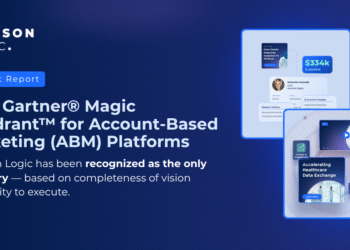In B2B marketing, two competing values sit at odds: personalization vs. operational complexity. On the one hand, account-based marketing (ABM) demands tailored, precise experiences for every stakeholder. On the other hand, the fragmented tech landscape encourages marketers to isolate their channels. The result? Inconsistency. Misalignment. Missed opportunities.
This isn’t just a tactical issue—it’s a philosophical one. An always-on, multi-channel nurturing strategy promises to deliver the right message to the right person at the right time. But without integration across those channels, you’re shouting into the void with half your team speaking a different language.
You may have inherited the ghost of old campaign-centric thinking—where each function ran their own programs. But the truth is that modern B2B lead nurturing is collective, contextual, and choreographed. Until you challenge the lie that more touchpoints equal more impact, your nurturing strategy efforts will plateau.
This post explores the four layers of conflict you face with disjoined channels and systems—philosophical, internal, personal, and external—and why the lack of integration is the silent killer of your lead nurturing success.
Philosophical Conflict: Fragmentation vs. Orchestration
Organizations may assume that casting a wider net across more platforms increases impact. In reality, when your channels aren’t integrated, your message is never truly heard—it’s scattered into fragments, showing up at the wrong moments, or in conflicting ways that leave the buying committee confused or disoriented.
Real success comes from orchestrating clear, consistent communication across all multi-channel ABM touchpoints so buying groups understand your value, and your nurturing is more effective in moving them forward in the buying journey.
Fragmentation occurs when you focus on your channels as their own independent silos, featuring exclusive offers or messaging in only one space. While you need to understand how to use each channel to optimize content, you don’t need to limit the messaging that you place there—you must be strategic about how and when you present it to buyers.
Let’s say that a stakeholder is just beginning to research their pain point and comes across a display ad highlighting a broad benefit of your solution. The stakeholder conducts a little more research, perhaps even visiting your website to look at your value proposition. Later, they receive an email that pushes a specific feature the buyer hasn’t explored—which leaves them feeling that your brand doesn’t understand their needs and that they need to look elsewhere for a solution that can address their issues.
Orchestration solves this scenario by aligning channel timing and content using shared data so that after engaging with an ad, the buyer receives an email that deepens that same narrative. Each touchpoint reinforces the last, creating a seamless experience that builds trust, maintains clarity, and accelerates buying decisions. Your channels need to always be on, offering the right message that will drive them deeper down the funnel.
To win with always-on ABM in your nurturing, orchestrate your content and messaging across channels and match it to each funnel stage and buyer persona. Use first-party data, intent data, and engagement insights from your customer relationship management solution (CRM), marketing automation platform (MAP), and ABM platform to guide when, where, and how you show up.
Internal Conflict: Strategy Without Sync
When marketing teams operate in silos, lead nurturing becomes fragmented and confusing. Without strategic alignment across roles and functions, your messages show out of sync with where buyers actually are—causing friction, distrust, and lost momentum in the journey.
This is more than a workflow hiccup; it’s a systemic breakdown. A sales email might highlight an advanced feature before the prospect has even grasped your core value proposition—because the nurture sequence is still focused on early-stage pain points. Or your paid team might launch a discount ad targeting an account still evaluating how your solution fits within their tech stack. These disjointed touchpoints don’t just underperform—they actively work against each other.
To fix it, teams must intentionally align across marketing functions (product, content, customer marketing, demand gen) and beyond (sales, customer success, RevOps) to break marketing silos. Regular cross-functional syncs should go beyond pipeline updates. They’re strategic moments to coordinate messaging, cadence, and data flows. When internal strategy is synchronized, external messaging becomes seamless—and buyers feel like they’re in conversation, not chaos.
Personal Conflict: The Buying Group Disconnect
B2B buying decisions involve multiple stakeholders—each with their own needs, timelines, and questions. When your channels aren’t integrated, they deliver misaligned messages to different personas at different stages, fracturing internal alignment and stalling the group’s ability to move forward.
Buying group decisions are already complex, with up to 11 stakeholders researching solutions on their own (and that’s within buying groups that can already average around 16 stakeholders). Disconnected messaging—like sending pricing to a CFO while the IT lead is still trying to understand what the tool does—only compounds complexity. Instead of building consensus, it creates confusion. The CFO now questions cost without context, while the IT lead isn’t ready to advocate for value. Momentum dies in the disconnect.
Centralize your view of account activity by linking CRM data, content engagement, and channel interactions. With an integrated understanding of role and stage through buying group identification, you can tailor nurture tracks that respect the internal decision-making process. Technical buyers get solutions-focused content first, and financial stakeholders receive ROI messaging only when it’s relevant. The result: a coordinated buying group that moves together—faster, clearer, and with more confidence.
External Conflict: Disjointed Touchpoints in the Wild
B2B buyers move between email, display advertising, search, and social channels expecting a seamless, relevant experience at every touchpoint. But siloed channels create touchpoints in the wild that give buyers noise instead of clarity. And this doesn’t work when they want personalization. When messages don’t match across channels, the experience feels random—not personal—and buyers lose trust and disengage because they doubt that your brand knows their needs and priorities.
Disjointed messaging confuses buyers and complicates internal decisions. Instead of reinforcing each other, different platforms compete for attention. Paid social may highlight a high-level benefit, while display advertising pushes an unrelated offer, and email assumes interest that hasn’t yet been earned. Without centralized data to coordinate timing, marketing teams can’t track which touchpoints truly impact buyers. This causes misallocated budgets, favoring loud channels over effective ones, and misses chances to nurture prospects with timely, relevant messages that drive pipeline growth.
The key to taming those wild touchpoints is a unified platform—one that consolidates data from every campaign and channel into a single, actionable view of the buyer’s journey. With this clarity, you can see how prospects move between touchpoints, identify which messages resonate, and coordinate timing to deliver the right content at the right moment. Without that integrated view, your nurture efforts stay reactive, your spend gets misdirected, and your buyer experience remains fragmented.
Solutions: How to Build an Integrated Lead Nurturing Framework
Fixing poor channel integration requires aligning content, teams, and technology. Here’s a plan of action to build an integrated lead nurturing framework covering the first 30 days through six months and beyond:
Immediate Actions (First 30 Days)
Start by identifying what’s working and what’s stalling your buyers. This diagnostic step ensures your content and buyer journey mapping align with the behavior of your buyers. Assess each touchpoint across channels to see whether it’s reinforcing progress or creating friction. Look for gaps in messaging, timing, and content relevance based on where accounts are in the journey.
Correcting these misalignments early enables more effective nurturing—where each message on any of your channels builds naturally on the last. Buyers stay engaged and move forward without having to backtrack or re-educate themselves.
Audit current messaging across all channels
If each person sees different, disconnected messages, it becomes harder for the buying group to align, move through the buying journey and trust your brand. Review how your brand shows up across all your channels and in sales outreach. Look for inconsistent tone, timing, or messaging by persona and funnel stage.
Identify gaps and overlaps in buyer journey experiences
These insights show you where disjointed experiences cause stalled decisions or trust breakdowns. Map the buyer’s journey by persona and channel. Where are buyers falling through the cracks? Where is content redundant or misaligned with engagement behavior?
Sustained Strategies (Next 1–6 Months)
Now you need to build systems and habits that ensure long-term consistency. Sustained integration efforts transform short-term fixes into scalable nurturing strategies. The next six months focus on creating an infrastructure that keeps messaging aligned, insight-driven, and responsive to your buyers’ needs.
Adopt orchestration tools and platforms
Invest in technology that integrates your MAP, customer data platform (CDP), and CRM to align channel activities with account insights. This unified view enables real-time campaign adjustments and delivers messages tailored to each buyer’s funnel stage.
Engage in consistent cross-functional team collaboration
Regular message alignment between content, demand gen, and sales teams is essential to deliver a consistent, unified experience across all touchpoints and optimize ABM performance.
Hold recurring syncs to unify your channels and sales outreach across the funnel. Use an ABM platform to consolidate channel data, refine targeting, optimize content across your marketing media mix, and clarify attribution. This unified view enables smarter, faster campaign optimization actions that boost engagement and conversions.
Cumulative Systems (6+ Months and Beyond)
Now it’s time to build systems that support long-term scalability and impact. This is where integration becomes embedded into your marketing culture. Integrated systems enable you stay consistent, adapt to changes in the buying group, and scale personalized nurturing without complexity.
Shift from campaign-based thinking to journey-based planning
This shift helps ensure buyers experience consistent messaging—even when multiple stakeholders join or leave the process over time. Replace fragmented, short-term campaigns with journey-based orchestration that aligns messaging by role, stage, and intent.
Create centralized content frameworks
A centralized framework helps teams maintain consistent messaging across all touchpoints for personalization at scale. Create content that you can split into multiple channels and match it to roles, funnel stages, and key value props.
Integration as a Strategic Differentiator
When your channels, teams, and data work in silos, you lose control of the buyer’s journey. Disconnected and irrelevant messaging hurts your communication with buyers—eroding trust and stalling momentum.
Integration changes this by unifying data and aligning every interaction with purpose. It enables you to deliver relevant, role-specific content at the right time that moves buyers forward instead of stopping them in their tracks.
This orchestration elevates B2B nurturing from scattered campaigns to a strategic growth engine—messages build trust, every dollar is accountable, and your marketing drives faster pipeline growth and stronger revenue.
Madison Logic: Your Partner for Integrated ABM Excellence
Madison Logic offers the platform and expertise to turn this vision into reality. We help you break down silos by integrating your MAP, CRM, and other data platforms into a unified system that powers smarter, more coordinated nurturing campaigns.
- Measure full-funnel impact: Understand how every channel and campaign drives pipeline and revenue
- Optimize in real time: Use unified cross-channel data to refine targeting, messaging, and media spend
- Accelerate conversions: Gain a complete view of each account’s journey, enabling timely, personalized interventions that speed deals forward
If you’re ready to turn ABM complexity into clarity, we’ll help you get there. Request a demo to see how.


















